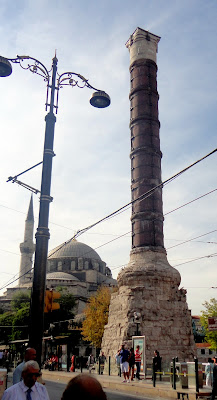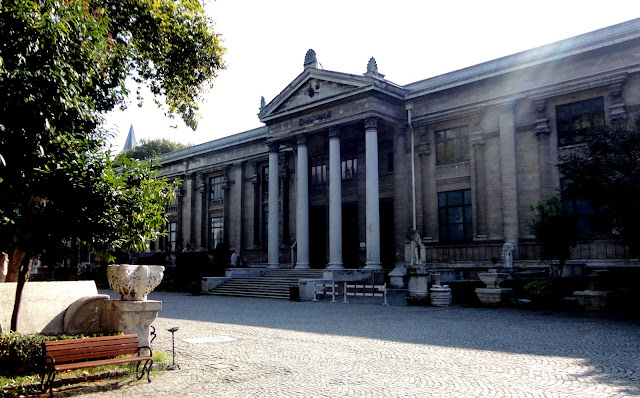So, after visiting Basilica Cistern we contoured Hagia Sophia and went into the direction of the Topkapı Palace, which had an entrance fee of 25 TL.
 |
| Entrance to the palace |
This huge complex of was the primary residence of the Ottoman Sultans for approximately 400 years. The palace complex consists of four main courtyards and many smaller buildings. At its peak, the palace was home to as many as 4,000 people and covered a large area with a long shoreline.
 |
| The view to the Bosphorus |
We were there at lunch hour, and still the queue was a bit long. There is
a lot to see here - we were in a rush so we couldn't afford to see the entire complex with the calm we wanted. I strongly advise you to spend a whole afternoon or even a whole day there if you are interested in history - the best way to get around is to buy an audio tour or a guide book.
 |
| Entrance to the war museum inside the palace |
 |
| No time for lunch, eating a 4 day-old croissant is enough |
Once you enter the big gate (with guards on each side) you'll find a big park with a splendid view to the Bosphorus. If you turn left, you'll see the Istanbul Archaeological Museums. When you reach the actual palace, you'll have the ticket office at your right. Once you've passed another gate, you'll be in the front palace garden. Even inside the palace you have queues to enter in the several rooms. What most impressed me was the treasury all, with all the gold, diamonds and crazy emeralds and sapphires.Would they notice if I borrowed on of those? =)
 |
| Some of the many treasures you can see inside the palace |
 |
| Like most of the monuments in Istanbul, Topkapi palace is beautifully decorated |
As the centuries passed the sultans built several small buildings which had many functions - private rooms, libraries, the turbans room, the circumcision building(??), etc. If you want to enjoy your visit even more you can buy and extra ticket and see the Harem, were all the female companions of the sultan lived.
 |
| One of the many rooms/small buildings that the sultans built over the centuries |
 |
| Inside the private library of the sultan |
I can't stress out enough how much this complex has to see. We were in a rush, we basically entered the places, took a quick glance and left. If you want to have the full experience, take some time (and a guidebook) to really see the palace.
 |
| Fine view to Istanbul's old town from the palace |
 |
| Part of the Milion |
The next stop was
Divan Yolu street, at the right of Ayasofia. This street was once the imperial road from Constantinople to Rome, laid out by Constantine the Great in the early 300s AD. The beginning-point of was marked by the
Milion: four towers at the corners of a square footing, topped by a dome. The Milion was apparently razed in the 15th century, but remnants of it were discovered in the 1960s, and a short marble shaft was re-erected at the northeastern end of Sultanahmet Square in the little park above Basilica Cistern. You'll have to look for it, because it's a small monument and can be easily missed. Divan Yolu is now the main avenue through historic Old Istanbul, starting at Sultanahmet Square (the square between Ayasofia and the Blue Mosque) and the Hippodrome and heading westward to the Grand Bazaar.
 |
| Part of the ancient city walls can be spotted at several places in the city |
 |
| The Burnt Column |
The road is full of shops and restaurants, past Ottoman sultans' tombs, mosques and souvenirs shops. If you want to bargain a bit, try it here. Further along the road you'll find
Çemberlitaş, the
Burnt Column -a Roman monumental column constructed on the orders of the Roman emperor Constantine in 330 AD. It commemorates the declaration of Byzantium as the new capital city of the Roman Empire. The Column of Constantine is one of the most important examples of Roman art in Istanbul. The column is 35 meters tall today. Restoration work has been going on since 1955. Cracks in the porphyry were filled and the metal brackets renewed in 1972. On its erection, the column was 50 meters tall, constructed of nine cylindrical porphyry blocks surmounted by a statue of Constantine in the figure of Apollo. Earthquakes and a fire in 1779 destroyed the neighborhood surrounding the column, leaving it with black scorch marks and earning it the name 'Burnt Column'.
A few dozen of meters ahead, you'll find the Grand Bazaar at your right. The bazaar is is one of the largest and oldest covered markets in the world, with 61 covered streets and over 3,000 shops. Once you get in, you'll have to orientate yourself because you can get easily lost. The market is packed with the most bedazzling stores - you can find everything there from souvenirs, fridge magnets, leather to real diamonds. You can and should bargain, but know that if you just want simple souvenirs like magnets or t-shirts, you'll probably find better prices on the streets.
 |
| One of the entrances to the Grand Bazaar |
 |
| A jewelery with lots and lots of gold in the bazaar |
 |
| A fine selection of natural herbs you can find in the bazaar |
Once we bought the sought-after souvenirs (at a slightly higher price I might add), we went to our last spot for the day, Beyazıt Square, were we could find the imponent Istanbul University's gate. The walled Istanbul University campus was built as the Ottoman Ministry of War, which accounts for its martial, fortress-like aspect. There was plenty to see here, such as the Mosque of Sultan Süleyman or the spice market, but after a day like this we were completely exhausted and went back to Divan Yolu street to eat something and went to the hotel.
 |
| Istanbul University's gate at Beyazıt Square |
The following day, a bit more refreshed, we woke up at 8 am an went straight to the
Istanbul Archaeology Museums, located just before the gate to Topkapı Palace with an entrance fee of 10 TL. The Archaeolgy museums are constituted by three buildings: Archaeological Museum (in the main building), the Museum of the Ancient Orient and the Museum of Islamic Art. On the way to the buildings you'll find relics in the sidewalk!
 |
| To many artifacts - why not put them on the sidewalk? |
We first visited the museum of Ancient Orient, with many, many interesting relics including the Kadesh Peace Treaty, the oldest known peace treaty in the world. You can also see artifacts of many civilizations the Egyptian, Sumerian among others.
 |
Part of the Kadesh Peace Treaty
|
 |
| Egyptians artifacts |
The next building was the Museum of Islamic Art. It's quite small, but the decoration is awesome! The tiles are amazing, you can really see the best of the Islamic decoration there.
 |
| Tiles from the Museum of Islamic Art |
Last but not the least, the Archaeological Museum, the main building, is pretty big and has lots and lots of interesting stuff to see. I found artifacts from nearly every place I went, like parts of the Serpent Column in the Hippodrome, Ayasofia and even the story of the Küçuk Ayasofya, that old mosque in front of our hotel! One of the most famous pieces is the Alexander Sarcophagus, once believed to be prepared for Alexander the Great.
 |
| The main building, the Archaeological Museum |
 |
| Alexander Sarcophagus |
This place really has a lot to see, but since we were in a hurry (the airport transfer was scheduled to 12pm) we couldn't appreciate it the way I wanted - 3 hours went really fast.
Back to the hotel, with 20 minutes to spare, we checked out, headed towards the airport and left for our next and final stop: Izmir.
My conclusion: Istanbul seems to be a bubbling city filled with life and lots and lots to see. With only one day and one morning I wasn't able to see the Sultanahmet area properly - only took a quick look and moved on. If you want to see the entire city, you'd need more than one week, perhaps two. It's really gigantic, but if you have the means to do so, you won't regret it.
 |
| One last glance to Istanbul... |
 |
| ... and a merhaba to Izmir! |
























No comments:
Post a Comment